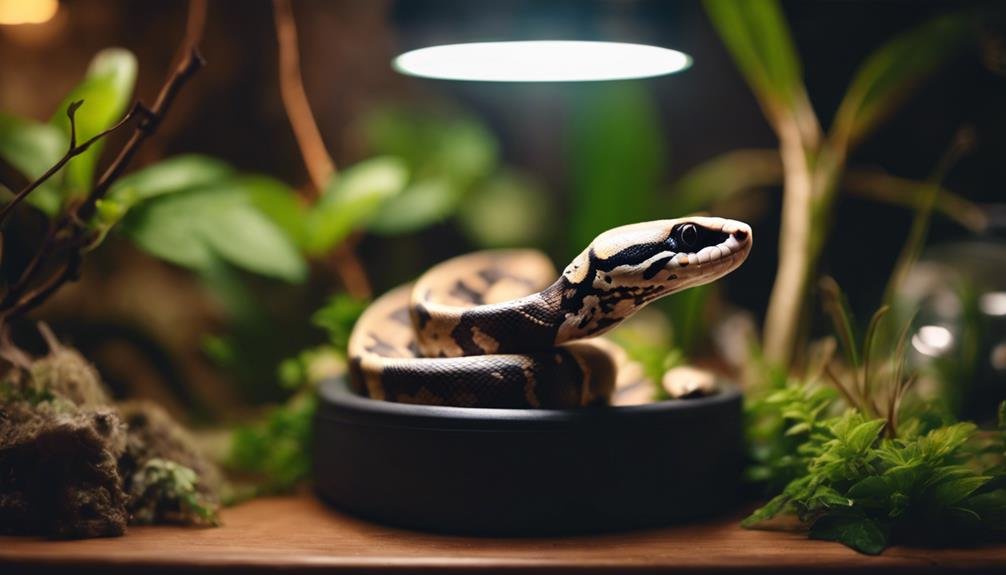When setting up a vivarium for your ball python, you're crafting more than just a home; you're replicating an ecosystem that's essential for their health and happiness. You've likely heard about the basics: a sizable enclosure, a precise temperature gradient, and the right humidity levels. However, the devil's in the details—like choosing the correct substrate and understanding the importance of hiding spots and water features. These elements aren't just about comfort; they're about simulating an environment that promotes natural behaviors and safeguards your snake's wellbeing. Let's explore how you can elevate your ball python's habitat beyond the basics, touching on aspects that often go overlooked but are pivotal for creating a thriving space.
Key Takeaways
- Vivarium should be at least 36 inches long to accommodate growth and promote well-being.
- Maintain a temperature gradient with a warm side (88-96°F) and a cool side (75-80°F).
- Ensure humidity levels are between 50-60%, using a hygrometer for monitoring.
- Provide at least two hiding spots in both warm and cool areas to reduce stress.
- Incorporate a consistent 12-14 hours of daylight cycle to support the ball python's circadian rhythm.
Enclosure Selection
Choosing the appropriate enclosure for your ball python is vital, as it impacts their health and happiness. Glass aquariums and commercially made reptile enclosures are your go-to options. Both offer clear views of your pet, but remember, the enclosure's size isn't just about fitting your snake; it's about accommodating its growth and ensuring there's ample space for movement and enrichment.
When setting up their home, substrate choices can't be taken lightly. You've got options like cage liners, aspen shavings, cypress mulch, coconut fiber substrate, or repti-bark. These substrates not only mimic their natural habitat but also aid in maintaining humidity levels which is essential for their shedding process.
Temperature regulation within the enclosure is non-negotiable. Implementing belly-heat ensures your ball python gets the warmth it needs from below, mirroring the natural heating they'd experience in the wild. Aim for a basking spot surface temperature between 90-92°F to keep them comfortable.
As for lighting, your snake doesn't require much. However, maintaining a cycle of 12-14 hours of daylight followed by 10-12 hours of nighttime will simulate a natural environment, promoting a healthy circadian rhythm.
Size and Space
When selecting a vivarium for your ball python, ensuring it's at least 36 inches long provides the necessary space for their well-being. This enclosure size is essential as it allows your snake to move around freely, which is important for their physical health and stress reduction. Remember, a ball python's habitat needs to mirror their natural environment as closely as possible, not just in size but also in offering both horizontal and vertical space. This setup encourages climbing and exploring, activities that are natural for them in the wild.
By providing a spacious vivarium, you're not just giving your ball python room to roam; you're also ensuring they've enough space for essential items like hiding spots and a water bowl without cluttering their living area. Such an environment is crucial for their mental health and promotes natural behaviors, contributing significantly to their overall quality of life.
Moreover, the right enclosure size is key to facilitating proper thermoregulation, allowing your ball python to move to cooler or warmer areas as needed, although we're not diving into temperature specifics here. In conclusion, the size and space of your ball python's vivarium play an important role in their health, happiness, and stress levels.
Temperature Gradient
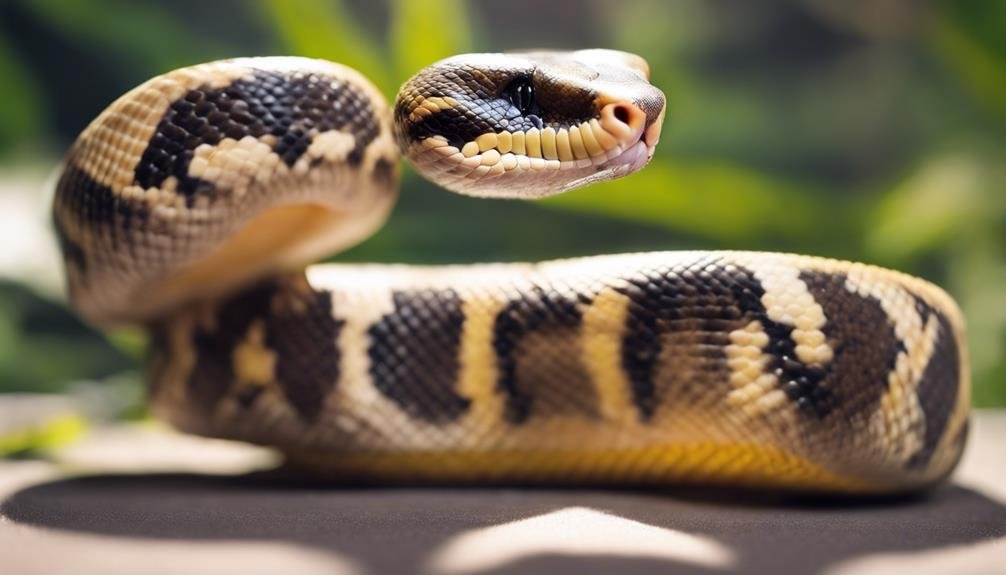

After ensuring your ball python's vivarium has ample space, it's equally important to focus on creating the right temperature gradient for their health and comfort. Ball python care demands a meticulous approach to managing their environment, especially when it comes to temperature. They require a temperature gradient within their vivarium, with a warm side measuring between 88-96°F and a cool side that ranges from 75-80°F. This differential is vital for allowing your ball python to regulate their body temperature effectively.
Providing a thermal gradient not only mimics their natural habitat but also enables them to thermoregulate by moving between the warmer and cooler areas. This is essential for their well-being, as it allows them to adjust their body temperature according to their needs, whether it's cooling down or warming up for digestion.
Moreover, a basking spot with a surface temperature of 90-92°F is ideal. This spot aids in digestion and maintains overall reptile health. Remember, maintaining the correct temperature gradient isn't just about comfort; it's essential to the well-being of your ball python in captivity, ensuring they lead a healthy and stress-free life.
Lighting Needs
While ball pythons don't need UV lighting due to their nocturnal nature, it's important to mimic their natural light cycle in captivity for their well-being. You don't have to worry about providing UV light specifically, as these snakes don't have a requirement for it to synthesize vitamin D like some other reptiles do. However, ensuring they experience a naturalistic environment is vital for their health and happiness.
Aiming for 12-14 hours of daylight followed by 10-12 hours of nighttime will closely resemble their natural habitat. This cycle not only supports their circadian rhythm but also helps regulate their body temperature and behavior. Utilizing a timer for your lighting setup can take the guesswork out of maintaining a consistent schedule, ensuring your ball python's day and night cycles are as regular as clockwork.
Humidity Control
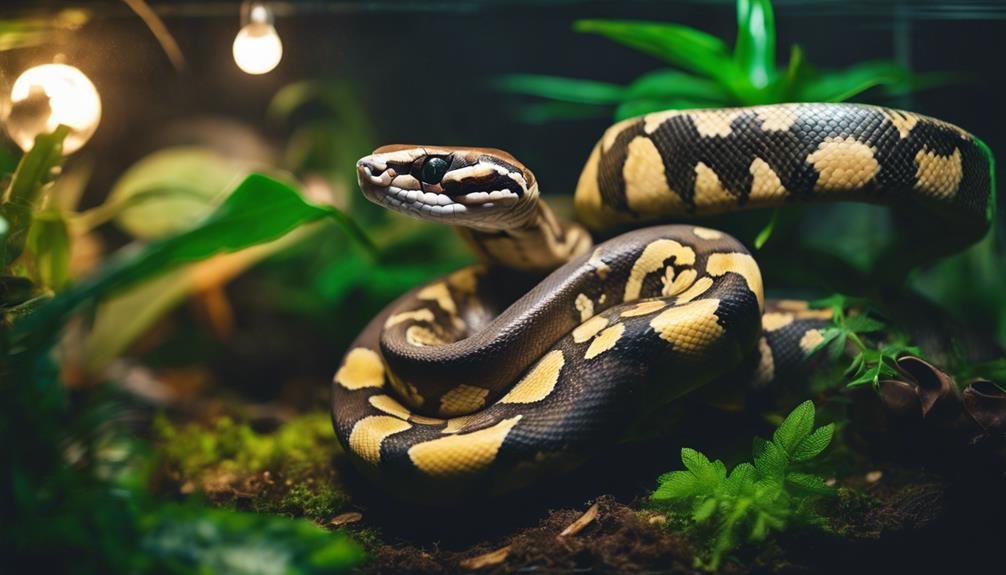

Moving on to humidity control, you'll find managing the right levels in your ball python's vivarium is key to their health.
You'll need to keep an eye on the humidity, using a gauge or hygrometer, to make sure it stays within the 50-60% range.
We'll also cover how adjusting humidity, through methods like a humidity box, can prevent common health issues.
Ideal Humidity Levels
In order for your ball python to thrive, it's imperative to maintain humidity levels within the ideal range of 50-60%. Keeping the humidity in this sweet spot using a hygrometer guarantees you're always on track, directly impacting your snake's wellbeing. Low humidity isn't just a minor inconvenience; it can lead to shedding issues and respiratory problems, both of which compromise your pet's health.
During shedding periods, it's particularly important to boost humidity levels, either by providing a humid hide or misting the enclosure. This extra moisture helps them shed their skin completely, avoiding any potential skin health issues. Remember, achieving and maintaining the right humidity levels is key to keeping your ball python healthy and happy in captivity.
Monitoring Humidity Methods
Understanding the ideal humidity levels for your ball python leads naturally to exploring how to accurately monitor and adjust these conditions within their vivarium. To maintain the recommended humidity levels between 50-60%, you'll need to use a digital hygrometer. This device gives you precise readings, ensuring the environment stays within the ideal range.
If you find the humidity dropping below these levels, misting the enclosure or using a humidifier can help boost moisture content. Additionally, providing a humid hide, filled with damp sphagnum moss, offers your snake a microenvironment to aid hydration and ease shedding complications.
It's essential to monitor humidity levels closely, especially during shedding periods, to prevent any issues that could arise from improper humidity.
Adjusting Humidity Tips
To keep your ball python healthy, you'll need to master adjusting the vivarium's humidity levels, making sure they stay within the ideal 50-60% range. Start by providing a humid hide filled with moistened sphagnum moss. This allows your snake to regulate its humidity needs independently.
If you find the humidity levels consistently low, consider adjusting your misting frequency or incorporating a reptile fogger to gently boost moisture levels. It's essential to monitor humidity with a reliable hygrometer placed strategically within the enclosure. This guarantees you're getting accurate readings.
Substrate Choices
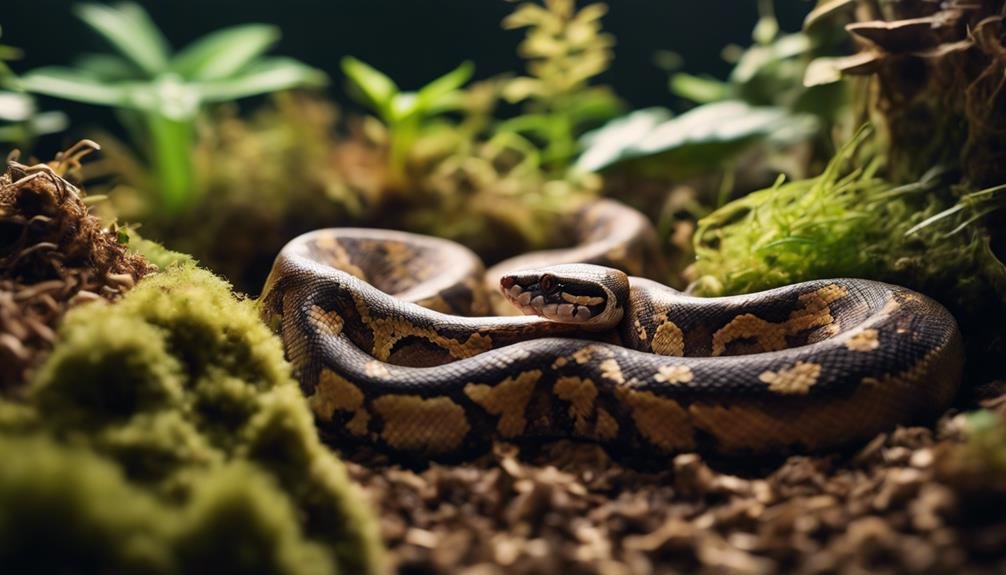

Selecting the right substrate is essential for your ball python's health and comfort in its vivarium. Among the popular substrate choices are aspen shavings, cypress mulch, coconut fiber substrate, and repti-bark. Each of these options is non-toxic, moisture absorbent, and easy to spot clean, ensuring the vivarium remains hygienic.
Cypress mulch stands out for its ability to retain humidity, an important factor for your ball python's proper shedding and overall health. This substrate choice helps create a stable environment that mimics the natural humidity levels your snake would experience in the wild. Meanwhile, repti-bark not only adds a naturalistic touch to the enclosure but also supports your ball python's instinctual burrowing behavior, offering them a sense of security and comfort.
Aspen shavings are favored for their affordability and ease of cleaning. Their natural appearance enhances the vivarium's aesthetics while providing a safe and comfortable bedding for your snake. Remember, the substrate isn't just about aesthetics; it plays an essential role in maintaining the right humidity levels and ensuring your ball python's well-being.
Hiding Spots
Moving on to hiding spots, it's essential you understand their significance in your ball python's enclosure.
You'll need to select materials that not only provide comfort but also resemble their natural habitat.
Ensuring these are placed in both warm and cool areas allows your snake to regulate its temperature effectively, keeping it healthy and stress-free.
Importance of Hiding
Understanding the significance of hiding spots is vital for your ball python's well-being and stress reduction. These creatures require at least two hiding spots in their vivarium to feel secure and lower their stress levels.
By providing hiding spots on both the warm and cool sides of the enclosure, you mimic their natural habitat, creating a comfortable and stress-free environment. These spots should be snug and enclosed, offering a sense of security that's important for their mental health.
Not only do proper hiding spots reduce stress, but they also help your ball python regulate its body temperature and aid in shedding. Make sure these hiding places are easily accessible and spacious enough for your snake to comfortably curl up inside, promoting a healthy and happy life for your pet.
Ideal Hiding Materials
Choosing the appropriate materials for your ball python's hiding spots can greatly enhance their comfort and security in the vivarium. Ball pythons need these refuges to feel secure and to greatly reduce stress. It's essential that the hiding spots are sized right, allowing your snake to snugly curl up inside.
Natural materials, such as cork bark, half logs, and rock caves, are ideal for these purposes. They not only provide a safe haven for your pet but also mimic their natural habitats, further promoting a sense of security.
Location Diversity
To guarantee your ball python's well-being, it's crucial to provide multiple hiding spots within their vivarium, each located in varied temperature zones. These hiding spots not only make your snake feel secure but greatly reduce stress by offering a sanctuary where they can comfortably curl up.
Make sure you have at least two comfortably sized hides: one in the warm area and another in the cooler part of the enclosure. This setup allows your ball python to regulate its temperature effectively, moving between hides to maintain ideal body heat. Opt for naturalistic hides, like hollow logs or caves, to mimic their natural habitat.
Incorporating diverse hiding spots that are well-placed and appropriately sized is key to creating a stress-free environment for your ball python.
Water and Hydration
Guaranteeing your ball python has access to fresh, clean water at all times is crucial for its hydration and overall health. Hydration plays a pivotal role in your snake's ability to digest food properly and shed its skin without issues. To support these crucial functions, you must provide a water bowl that's adequately sized for your python to both drink from and soak in if it chooses.
Consider these essential pointers to create the perfect hydration station for your ball python:
- *Select a water bowl that's large enough for your ball python to immerse itself, aiding in shedding and hydration.*
- *Place the water bowl in a stable area of the vivarium to prevent spills and ensure easy access.*
- *Regularly replace the water to keep it clean and free from contaminants, supporting your python's health.*
- *Consider the bowl's material—ceramic or heavy plastic can prevent tipping and maintain cleanliness.*
- *Monitor the water temperature to keep it at a comfortable level for your snake, aiding in digestion and overall well-being.*
Adequate hydration is more than just a convenience; it's a cornerstone of your ball python's health, facilitating smooth digestion, effortless shedding, and a well-regulated body temperature.
Cleaning Protocols
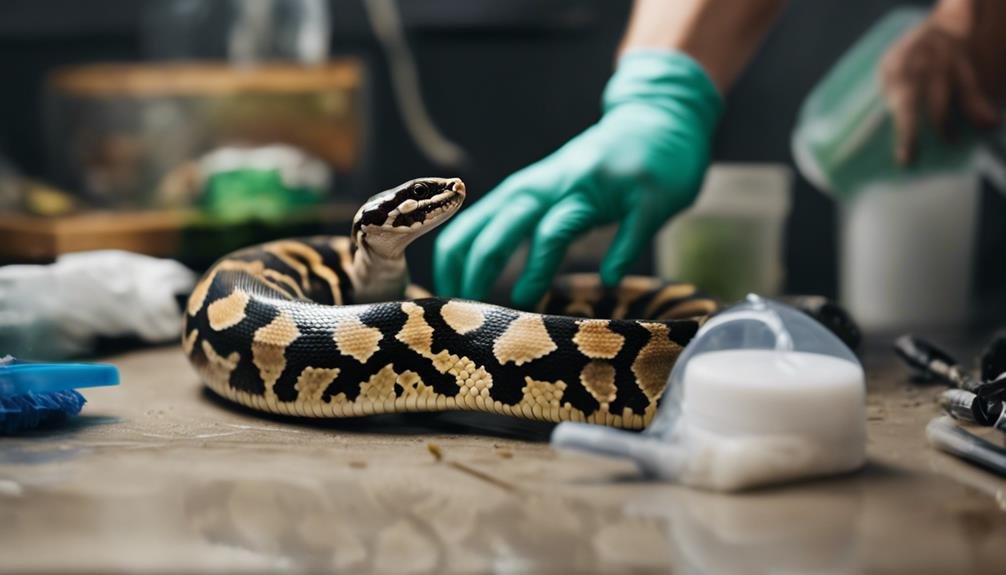

Maintaining a clean vivarium is essential for your ball python's health, requiring regular cleaning protocols that include spot cleaning, substrate replacement, and disinfection of the habitat. The cleanliness of the enclosure directly impacts your snake's wellbeing, making it vital to stay vigilant. When you notice feces or urates, immediately spot clean the area to maintain hygiene and prevent the growth of harmful bacteria.
Every 3-4 months, it's vital to replace the substrate entirely. This prevents bacterial build-up and guarantees a healthy environment for your ball python. Don't overlook the significance of this step; a clean substrate is foundational to a sanitary habitat.
Moreover, a deep clean of the entire enclosure is necessary every 6 months. Use a reptile-safe disinfectant, such as F10SC or a properly diluted bleach solution, to thoroughly disinfect the habitat and eliminate any lurking pathogens or contaminants. This deep clean should extend to washing and disinfecting the water and food bowls, which are hotspots for bacteria growth.
Additionally, any decor or accessories within the enclosure require cleaning and disinfection to assure a fully sanitary environment. Remember, a clean vivarium is a cornerstone of your ball python's health and happiness.
Do Ball Python Vivarium Requirements Include the Need for UVB Lighting?
Yes, ball pythons uvb lighting impact their overall health and well-being. While UVB lighting is not an absolute requirement for ball pythons, it can positively impact their calcium absorption and aid in preventing metabolic bone disease. Providing a balanced UVB lighting source can contribute to a thriving vivarium environment for these reptiles.
Enrichment and Accessories
Moving beyond the basics, let's focus on the enrichment and accessories that can transform your ball python's vivarium into a stimulating home.
Including climbing structures and a variety of hiding spots not only mimics their natural habitat but also supports their physical and mental health.
Additionally, incorporating water features can offer both aesthetic appeal and practical benefits for your snake's environment.
Climbing Structures Importance
Incorporating climbing structures into your ball python's vivarium is essential for their physical and mental well-being, offering necessary exercise and replicating their natural environment. These installations not only mimic their natural habitat but also play an important role in obesity prevention, ensuring your snake maintains good physical health and muscle tone.
Additionally, climbing structures offer mental stimulation, reducing stress and preventing boredom. They encourage your ball python to explore and utilize vertical space efficiently, promoting a sense of security.
- Branches for simulating tree environments
- Logs to provide natural obstacles
- Shelves for resting and surveying the vivarium
- Ropes for added complexity and exercise
- Sturdy plants that offer both climbing and aesthetic value
Hiding Spots Variety
After exploring the role of climbing structures in your ball python's vivarium, it's important to focus on the variety of hiding spots to further enrich their living environment.
Your ball python needs hide boxes on both the warm and cool sides of their enclosure to guarantee security and comfort. Including different types of hiding spots, such as caves and logs, mimics their natural habitat, providing essential enrichment.
These spots should be snug enough for your snake to curl up in, offering a sense of security, which is vital for stress reduction. Diverse hiding options not only encourage exploration but also allow your pet to regulate its body temperature efficiently.
This variety adds to the vivarium's dynamic environment, boosting mental stimulation and promoting your ball python's overall well-being.
Water Features Benefits
Introducing water features, such as shallow pools or dishes, provides your ball python with essential hydration and a naturalistic environment to explore. These features not only quench their thirst but also play an important role in mimicking their native habitat, boosting their overall health and happiness. Here's how adding a water feature can transform your pet's vivarium:
- Hydration: Offers a readily available source of water for drinking and soaking.
- Humidity: Increases enclosure humidity, aiding in smooth sheds and respiratory health.
- Behavior: Encourages exploration and soaking behaviors, offering mental and physical stimulation.
- Visual Interest: Adds a dynamic, visually appealing element to the setup.
- Natural Habitat: Helps recreate a slice of the wild, enhancing your snake's well-being.
Incorporating water features into your ball python's vivarium brings a touch of the wild indoors, supporting their hydration, health, and happiness.
Frequently Asked Questions
What Do Ball Pythons Need in Their Enclosure?
You need to set up a comfy home for your ball python that includes proper temperature control and humidity levels, along with a smart substrate choice.
Don't forget to add hiding spots and climbing structures to mimic their natural habitat. A water bowl is essential for hydration, and you've got to get the lighting needs right for their day-night cycle.
Regularly clean the enclosure to keep your slithery friend healthy and happy!
What Size Vivarium Does a Ball Python Need?
You're looking for the right size vivarium for your ball python, aren't you? Aim for at least 36' x 18' x 12'. This size supports temperature control, proper humidity levels, a suitable lighting setup, and a secure lid.
Don't forget a good ventilation system, the right substrate choice, and plenty of hide spots. These elements are essential for their health and mimic their natural habitat, keeping your slithery friend happy and active.
Is 40 Gallon Big Enough for Ball Python?
Yes, a 40-gallon tank is big enough for a ball python, especially when you're starting with a juvenile. However, you'll need to guarantee it has a secure lid, proper temperature control, and appropriate humidity levels.
Don't forget to add climbing branches, substrate options for burrowing, hide spots for security, and a water bowl for hydration. These elements are key to keeping your ball python healthy and happy in its environment.
Is a 75 Gallon Tank Good for a Ball Python?
Yes, a 75-gallon tank is great for a ball python. You'll need to focus on tank placement to maintain a stable environment. Control humidity and create a thermal gradient for your python's health. Don't forget the importance of ventilation for fresh air.
Lighting should mimic natural cycles, and choose a substrate that supports humidity. Add enrichment like hides and branches to keep your python engaged. This setup will help your python thrive.
Conclusion
In summary, you've got to guarantee your ball python's vivarium is excellent for their health and happiness. Choose a spacious enclosure, maintain a cozy temperature gradient, and don't skimp on the lighting and humidity control. Remember to include hiding spots and a water bowl to mimic their natural habitat.
Keep their home clean and throw in some enrichment accessories for good measure. By following these guidelines, you'll create a comfortable and stimulating environment for your slithery friend.

